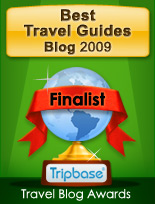 Do all but the most impressively striking of archaeological ruins look like piles of rubble to you? You can’t be blamed. So many guidebooks give such glowing reviews of ancient sites and write so evocatively about them that, regardless of the condition they're in, or how important or interesting they may be, the completists among us just can’t resist ticking them off. Yet, unless you’re an archaeologist or historian, some sites simply may not be all that compelling. For one, the ruins may be so ruined, it's impossible to even identify what they were. Here are some tips to getting more out of the experience:
Do all but the most impressively striking of archaeological ruins look like piles of rubble to you? You can’t be blamed. So many guidebooks give such glowing reviews of ancient sites and write so evocatively about them that, regardless of the condition they're in, or how important or interesting they may be, the completists among us just can’t resist ticking them off. Yet, unless you’re an archaeologist or historian, some sites simply may not be all that compelling. For one, the ruins may be so ruined, it's impossible to even identify what they were. Here are some tips to getting more out of the experience:
1. Read about the ruins before you visit and go beyond that one column in the guidebook. Thumb through a history book or guide by a respected archaeologist who specializes in the period/area you’re visiting and knows how to write. For instance, for Syria, Ross Burns’ Monuments of Syria* is a must. With a more complete understanding of the site’s history, society, culture, who lived there, why they built it, what happened to them, and why it’s important, you’ll get so much more out of the experience.
2. Visit the nearest archaeological museum before you head to the site, because seeing the extraordinary tablets, splendid statues, fascinating artefacts, exquisite jewellery, and perfectly-formed pottery and glass, found at a site will bring those old rocks and mounds of dirt to life. As you wander the site, you’ll better appreciate the place in which they were made and used, and get a kick out of making connections between the stuff on display and the people who created it.
3. Get a map of the site and use it. Whether it's the map on the site's own brochure, or, better yet, one from a book like Burns’ Monuments of Syria, follow it. Don't just wander around aimlessly. The map will help you make sense of the rubble and help you to see that those low stone walls you're looking at were actually rooms within a grand palace. With a bit of imagination, you'll be visualizing a whole city in no time.
* I could happily travel Syria with Burns’ book alone to guide me, but if you’re planning a trip do look out for our update of our Lonely Planet’s Syria and Lebanon guide coming out mid-year. We’ve include an enlightening interview with archaeologist Greg Fisher who we met in Damascus. Unfortunately we can’t reproduce that interview here, but maybe Greg will email in with some additional tips.
Thursday, March 20, 2008
The Cool Travel Guide to: getting the most out of archaeological sites (part 1)
Posted by
Lara Dunston
at
12:31 AM
![]()
Labels: archaeological sites, Syria, touristic experiences, travel tips
Subscribe to:
Post Comments (Atom)


























2 comments:
What about a compass! Many times we've found that we're a little disoriented when the archaeologist writes 'to the north-east of the site, you'll see...'
Great idea! I also found that a GPS comes in handy if you're looking for an ancient palace in the middle of the desert...
Post a Comment